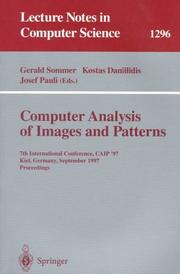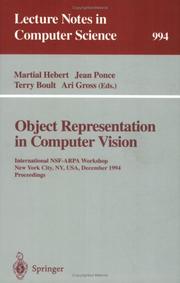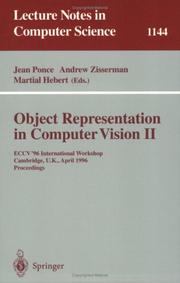| Listing 1 - 8 of 8 |
Sort by
|

ISBN: 3540634606 9783540634607 Year: 1997 Volume: 1296 Publisher: Berlin: Springer,
Abstract | Keywords | Export | Availability | Bookmark
 Loading...
Loading...Choose an application
- Reference Manager
- EndNote
- RefWorks (Direct export to RefWorks)
This book constitutes the refereed proceedings of the 7th International Conference on Computer Analysis of Images and Patterns, CAIP '97, held in Kiel, Germany, in September 1997. The volume presents 92 revised papers selected during a double-blind reviewing process from a total of 150 high-quality submissions. The papers are organized in topical sections on pattern analysis, object recognition and tracking, invariants, applications, shape, texture analysis, motion calibration, low-level processing, structure from motion, stereo and correspondence, segmentation and grouping, mathematical morphology, pose estimation, and face analysis.

ISBN: 075030121X 9780750301213 Year: 1991 Publisher: Bristol: Hilger,
Abstract | Keywords | Export | Availability | Bookmark
 Loading...
Loading...Choose an application
- Reference Manager
- EndNote
- RefWorks (Direct export to RefWorks)
Optical pattern recognition --- Image processing --- Physics --- Congresses. --- Image processing. --- Optical pattern recognition - Congresses. --- Image processing - Congresses. --- Physics - Congresses.

ISBN: 3540604774 0387604774 3540475265 9783540604778 Year: 1995 Volume: 994 Publisher: Berlin: Springer,
Abstract | Keywords | Export | Availability | Bookmark
 Loading...
Loading...Choose an application
- Reference Manager
- EndNote
- RefWorks (Direct export to RefWorks)
This book documents the scientific outcome of the International NSF-ARPA Workshop on Object Representation in Computer Vision, held in New York City in December 1994 with invited participants chosen among the recognized experts in the field. The volume presents the complete set of papers in revised full-length versions. In addition, the first paper is a report on the workshop in which the panel discussions as well as the conclusions and recommendations reached by the workshop participants are summarized. Altogether the volume provides an excellent, in-depth view of the state of the art in this active area of research and applications.
Computer vision --- Optical pattern recognition --- Image processing --- Object-oriented methods (Computer science) --- Congresses. --- Digital techniques --- Congresses --- Computer vision. --- Computer science. --- Optical pattern recognition. --- Computer graphics. --- Artificial intelligence. --- Image Processing and Computer Vision. --- Computer Applications. --- Robotics and Automation. --- Pattern Recognition. --- Computer Graphics. --- Artificial Intelligence. --- AI (Artificial intelligence) --- Artificial thinking --- Electronic brains --- Intellectronics --- Intelligence, Artificial --- Intelligent machines --- Machine intelligence --- Thinking, Artificial --- Bionics --- Cognitive science --- Digital computer simulation --- Electronic data processing --- Logic machines --- Machine theory --- Self-organizing systems --- Simulation methods --- Fifth generation computers --- Neural computers --- Automatic drafting --- Graphic data processing --- Graphics, Computer --- Computer art --- Graphic arts --- Engineering graphics --- Optical data processing --- Pattern perception --- Perceptrons --- Visual discrimination --- Informatics --- Science --- Machine vision --- Vision, Computer --- Artificial intelligence --- Pattern recognition systems --- Computer vision - Congresses. --- Optical pattern recognition - Congresses. --- Image processing - Digital techniques - Congresses. --- Object-oriented methods (Computer science) - Congresses.

ISBN: 3540617507 3540706739 9783540617501 Year: 1996 Volume: 1144 Publisher: Berlin: Springer,
Abstract | Keywords | Export | Availability | Bookmark
 Loading...
Loading...Choose an application
- Reference Manager
- EndNote
- RefWorks (Direct export to RefWorks)
This book constitutes the strictly refereed post-workshop proceedings of the second International Workshop on Object Representation in Computer Vision, held in conjunction with ECCV '96 in Cambridge, UK, in April 1996. The 15 revised full papers contained in the book were selected from 45 submissions for presentation at the workshop. Also included are three invited contributions based on the talks by Takeo Kanade, Jan Koenderink, and Ram Nevatia as well as a workshop report by the volume editors summarizing several panel discussions and the general state of the art in the area.
Computer vision --- Object-oriented methods (Computer science) --- Optical pattern recognition --- Image processing --- Congresses. --- Digital techniques --- -Image processing --- -Object-oriented methods (Computer science) --- -Optical pattern recognition --- -#TELE:MI2 --- Optical data processing --- Pattern perception --- Perceptrons --- Visual discrimination --- Pictorial data processing --- Picture processing --- Processing, Image --- Imaging systems --- Machine vision --- Vision, Computer --- Artificial intelligence --- Pattern recognition systems --- Congresses --- -Congresses --- Conferences - Meetings --- #TELE:MI2 --- Digital techniques&delete& --- Computer vision. --- Optical pattern recognition. --- Computer graphics. --- Artificial intelligence. --- Engineering. --- Image Processing and Computer Vision. --- Pattern Recognition. --- Computer Graphics. --- Artificial Intelligence. --- Complexity. --- Construction --- Industrial arts --- Technology --- AI (Artificial intelligence) --- Artificial thinking --- Electronic brains --- Intellectronics --- Intelligence, Artificial --- Intelligent machines --- Machine intelligence --- Thinking, Artificial --- Bionics --- Cognitive science --- Digital computer simulation --- Electronic data processing --- Logic machines --- Machine theory --- Self-organizing systems --- Simulation methods --- Fifth generation computers --- Neural computers --- Automatic drafting --- Graphic data processing --- Graphics, Computer --- Computer art --- Graphic arts --- Engineering graphics --- Computer vision - Congresses. --- Object-oriented methods (Computer science) - Congresses. --- Optical pattern recognition - Congresses. --- Image processing - Digital techniques - Congresses.
Book
ISBN: 1447159764 1447140710 9786613767721 1447140729 1280996110 Year: 2012 Publisher: London ; New York : Springer,
Abstract | Keywords | Export | Availability | Bookmark
 Loading...
Loading...Choose an application
- Reference Manager
- EndNote
- RefWorks (Direct export to RefWorks)
Optical Character Recognition (OCR) is a key technology enabling access to digital text data. This technique is especially valuable for Arabic scripts, for which there has been very little digital access. Arabic script is widely used today. It is estimated that approximately 200 million people use Arabic as a first language, and the Arabic script is shared by an additional 13 languages, making it the second most widespread script in the world. However, Arabic scripts pose unique challenges for OCR systems that cannot be simply adapted from existing Latin character-based processing techniques. This comprehensive Guide to OCR for Arabic Scripts is the first book of its kind, specifically devoted to this emerging field. Presenting state-of-the-art research from an international selection of pre-eminent authorities, the book reviews techniques and algorithms for the recognition of both handwritten and printed Arabic scripts. Many of these techniques can also be applied to other scripts, serving as an inspiration to all groups working in the area of OCR. Topics and features: Contains contributions from the leading researchers in the field With a Foreword by Professor Bente Maegaard of the University of Copenhagen Presents a detailed overview of Arabic character recognition technology, covering a range of different aspects of pre-processing and feature extraction Reviews a broad selection of varying approaches, including HMM-based methods and a recognition system based on multidimensional recurrent neural networks Examines the evaluation of Arabic script recognition systems, discussing data collection and annotation, benchmarking strategies, and handwriting recognition competitions Describes numerous applications of Arabic script recognition technology, from historical Arabic manuscripts to online Arabic recognition This authoritative work is an essential reference for all researchers and graduate students interested in OCR technology and methodology in general, and in Arabic scripts in particular.
Document imaging systems -- Congresses. --- Optical pattern recognition -- Congresses. --- Optical character recognition --- Arabic character sets (Data processing) --- Engineering & Applied Sciences --- Applied Physics --- Optical character recognition. --- OCR (Optical character recognition) --- Computer science. --- Text processing (Computer science). --- Image processing. --- Pattern recognition. --- Computer Science. --- Image Processing and Computer Vision. --- Document Preparation and Text Processing. --- Pattern Recognition. --- Arabic language --- Character sets (Data processing) --- Optical pattern recognition --- Data processing --- Computer vision. --- Natural language processing (Computer science). --- Optical pattern recognition. --- Natural Language Processing (NLP). --- Optical data processing --- Pattern perception --- Perceptrons --- Visual discrimination --- NLP (Computer science) --- Artificial intelligence --- Electronic data processing --- Human-computer interaction --- Semantic computing --- Machine vision --- Vision, Computer --- Image processing --- Pattern recognition systems --- Optical data processing. --- Design perception --- Pattern recognition --- Form perception --- Perception --- Figure-ground perception --- Optical computing --- Visual data processing --- Bionics --- Integrated optics --- Photonics --- Computers --- Optical equipment
Book
ISBN: 1461453224 1461453232 1283741776 9781461453222 Year: 2013 Publisher: New York: Springer,
Abstract | Keywords | Export | Availability | Bookmark
 Loading...
Loading...Choose an application
- Reference Manager
- EndNote
- RefWorks (Direct export to RefWorks)
The use of pattern recognition and classification is fundamental to many of the automated electronic systems in use today. However, despite the existence of a number of notable books in the field, the subject remains very challenging, especially for the beginner. Pattern Recognition and Classification presents a comprehensive introduction to the core concepts involved in automated pattern recognition. It is designed to be accessible to newcomers from varied backgrounds, but it will also be useful to researchers and professionals in image and signal processing and analysis, and in computer vision. Fundamental concepts of supervised and unsupervised classification are presented in an informal, rather than axiomatic, treatment so that the reader can quickly acquire the necessary background for applying the concepts to real problems. More advanced topics, such as estimating classifier performance and combining classifiers, and details of particular project applications are addressed in the later chapters. This book is suitable for undergraduates and graduates studying pattern recognition and machine learning.
Image processing --Digital techniques -- Congresses. --- Optical pattern recognition -- Congresses. --- Electrical & Computer Engineering --- Engineering & Applied Sciences --- Computer Science --- Electrical Engineering --- Pattern recognition systems. --- Image processing. --- Pictorial data processing --- Picture processing --- Processing, Image --- Pattern classification systems --- Pattern recognition computers --- Computer science. --- Pattern recognition. --- Bioinformatics. --- Computational biology. --- Algorithms. --- Statistical physics. --- Computer Science. --- Pattern Recognition. --- Nonlinear Dynamics. --- Signal, Image and Speech Processing. --- Computer Appl. in Life Sciences. --- Imaging systems --- Optical data processing --- Pattern perception --- Computer vision --- Optical pattern recognition. --- Biology --- Applications of Nonlinear Dynamics and Chaos Theory. --- Data processing. --- Algorism --- Algebra --- Arithmetic --- Perceptrons --- Visual discrimination --- Foundations --- Signal processing. --- Speech processing systems. --- Bioinformatics . --- Computational biology . --- Computational linguistics --- Electronic systems --- Information theory --- Modulation theory --- Oral communication --- Speech --- Telecommunication --- Singing voice synthesizers --- Processing, Signal --- Information measurement --- Signal theory (Telecommunication) --- Physics --- Mathematical statistics --- Design perception --- Pattern recognition --- Form perception --- Perception --- Figure-ground perception --- Bioinformatics --- Bio-informatics --- Biological informatics --- Information science --- Computational biology --- Systems biology --- Statistical methods --- Data processing --- Optical pattern recognition --- Biology - Data processing --- Algorithms

ISBN: 9783540728467 3540728465 9783540728481 3540728481 3540728473 9786610951666 1280951664 354072849X Year: 2007 Publisher: Berlin New York : Springer,
Abstract | Keywords | Export | Availability | Bookmark
 Loading...
Loading...Choose an application
- Reference Manager
- EndNote
- RefWorks (Direct export to RefWorks)
Optical pattern recognition --- Pattern recognition systems --- Image processing --- Computer vision --- Reconnaissance optique des formes (Informatique) --- Reconnaissance des formes (Informatique) --- Traitement d'images --- Vision par ordinateur --- Congresses. --- Congrès --- Computer vision -- Congresses. --- Image processing -- Congresses. --- Optical pattern recognition -- Congresses. --- Pattern recognition systems -- Congresses. --- Applied Physics --- Engineering & Applied Sciences --- Computer science. --- Artificial intelligence. --- Text processing (Computer science). --- Computer graphics. --- Image processing. --- Pattern recognition. --- Computer Science. --- Pattern Recognition. --- Image Processing and Computer Vision. --- Document Preparation and Text Processing. --- Artificial Intelligence (incl. Robotics). --- Computer Graphics. --- Design perception --- Pattern recognition --- Form perception --- Perception --- Figure-ground perception --- Pictorial data processing --- Picture processing --- Processing, Image --- Imaging systems --- Optical data processing --- Automatic drafting --- Graphic data processing --- Graphics, Computer --- Computer art --- Graphic arts --- Electronic data processing --- Engineering graphics --- Processing, Text (Computer science) --- Database management --- Information storage and retrieval systems --- Word processing --- AI (Artificial intelligence) --- Artificial thinking --- Electronic brains --- Intellectronics --- Intelligence, Artificial --- Intelligent machines --- Machine intelligence --- Thinking, Artificial --- Bionics --- Cognitive science --- Digital computer simulation --- Logic machines --- Machine theory --- Self-organizing systems --- Simulation methods --- Fifth generation computers --- Neural computers --- Informatics --- Science --- Digital techniques --- Optical pattern recognition. --- Computer vision. --- Natural language processing (Computer science). --- Natural Language Processing (NLP). --- Artificial Intelligence. --- NLP (Computer science) --- Artificial intelligence --- Human-computer interaction --- Semantic computing --- Machine vision --- Vision, Computer --- Pattern perception --- Perceptrons --- Visual discrimination --- Optical data processing. --- Optical computing --- Visual data processing --- Integrated optics --- Photonics --- Computers --- Optical equipment

ISBN: 3540425969 9786610969616 128096961X 3540454047 Year: 2001 Publisher: Berlin, Heidelberg : Springer Berlin Heidelberg : Imprint: Springer,
Abstract | Keywords | Export | Availability | Bookmark
 Loading...
Loading...Choose an application
- Reference Manager
- EndNote
- RefWorks (Direct export to RefWorks)
Sometimes milestones in the evolution of the DAGM Symposium become immediately visible. The Technical Committee decided to publish the symposium proceedings completely in English. As a consequence we successfully negotiated with Springer Verlag to publish in the international well accepted series “Lecture Notes in Computer Science”. The quality of the contributions convinced the editors and the lectors. Thanks to them and to the authors. We received 105 acceptable, good, and even excellent manuscripts. We selected carefully, using three reviewers for each anonymized paper, 58 talks and posters. Our 41 reviewers had a hard job evaluating and especially rejecting contributions. We are grateful for the time and effort they spent in this task. The program committee awarded prizes to the best papers. We are much obliged to the generous sponsors. We had three invited talks from outstanding colleagues, namely Bernhard Nebel (Robot Soccer – A Challenge for Cooperative Action and Perception), Thomas Lengauer (Computational Biology – An Interdisciplinary Challenge for Computational Pattern Recognition), and Nassir Navab (Medical and Industrial Augmented Reality: Challenges for Real Time Vision, Computer Graphics, and Mobile Computing). N. Navab even wrote a special paper for this conference, which is included in the proceedings. We were proud that we could convince well known experts to offer tutorials to our participants: H. P. Seidel, Univ. Saarbrücken – A Framework for the Acquisition, Processing, and Interactive Display of High Quality 3D Models; S. Heuel, Univ. Bonn – Projective Geometry for Grouping and Orientation Tasks; G. Rigoll, Univ.
Electronic books. -- local. --- Image processing -- Digital techniques -- Congresses. --- Optical pattern recognition -- Congresses. --- Optical pattern recognition --- Image processing --- Applied Physics --- Engineering & Applied Sciences --- Digital techniques --- Computer science. --- Artificial intelligence. --- Computer graphics. --- Image processing. --- Pattern recognition. --- Application software. --- Computer Science. --- Pattern Recognition. --- Computer Applications. --- Image Processing and Computer Vision. --- Computer Graphics. --- Artificial Intelligence (incl. Robotics). --- Optical pattern recognition. --- Computer vision. --- Artificial Intelligence. --- AI (Artificial intelligence) --- Artificial thinking --- Electronic brains --- Intellectronics --- Intelligence, Artificial --- Intelligent machines --- Machine intelligence --- Thinking, Artificial --- Bionics --- Cognitive science --- Digital computer simulation --- Electronic data processing --- Logic machines --- Machine theory --- Self-organizing systems --- Simulation methods --- Fifth generation computers --- Neural computers --- Automatic drafting --- Graphic data processing --- Graphics, Computer --- Computer art --- Graphic arts --- Engineering graphics --- Machine vision --- Vision, Computer --- Artificial intelligence --- Pattern recognition systems --- Informatics --- Science --- Optical data processing --- Pattern perception --- Perceptrons --- Visual discrimination --- Optical data processing. --- Optical computing --- Visual data processing --- Integrated optics --- Photonics --- Computers --- Application computer programs --- Application computer software --- Applications software --- Apps (Computer software) --- Computer software --- Design perception --- Pattern recognition --- Form perception --- Perception --- Figure-ground perception --- Optical equipment --- Pattern perception.
| Listing 1 - 8 of 8 |
Sort by
|

 Search
Search Feedback
Feedback About UniCat
About UniCat  Help
Help News
News